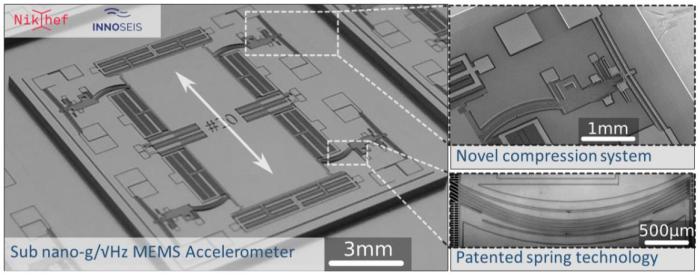Sub nano-g MEMS accelerometer for high precision orbital manoeuvres

To realize the next generation of gravitational wave detectors, Nikhef, the Dutch National Institute for Subatomic Physics started developing a novel seismic sensor: An ultra-sensitive miniaturised accelerometer made in micro-electro- mechanical system (MEMS) technology. The goal was to develop an affordable accelerometer that was as sensitive as conventional seismometers, but significantly smaller and cheaper. Innoseis, a spin-off company, has been licensed to bring this cutting-edge technology to market.
The main academic objective was to develop the world’s most sensitive and compact accelerometer in the low-frequency (0 – 100 Hz) regime that can be produced in large quantities. This is needed to improve the sensitivity of next generation gravitational waves detectors such as Einstein Telescope. This facility should be operational by around 2030 to image the universe with gravitational waves with ten-fold improved sensitivity compared to current detectors. Networks of accelerometers are foreseen to map the seismic wavefields nearby, to compensate for the tiny gravitational fluctuations they produce.
In addition to the academic objectives, many more applications for a high sensitivity and cost-effective MEMS accelerometer are foreseen. Accelerometers, or inertial sensors, are everywhere and key sensory elements for crucial societal goals from addressing climate change, to safe transportation and the space revolution. They are used, for example, to monitor the integrity of bridges, buildings, and infrastructure. In combination with relative positioning systems such as GPS, inertial sensors can offer precision improvements to the where-abouts of vehicles, be they on the road, under water, or in the sky.
Innoseis was founded in 2013 with the objective of exploiting the fundamental physics research conducted in the gravitation waves group of Nikhef. It has had much success in disrupting industries with innovative, high precision, low power sensing products. It has now set its sights on the broad application areas of this novel MEMS accelerometer. The applicability of the sensor to the (aero)space markets was the topic of this activity.
The MEMS accelerometer has already proven world record sensitivity, which is more than an order of magnitude better than the current state-of-the-art. This sensitivity was reached in a laboratory setup as well as having been demonstrated outsideof the laboratory and side-by-side with conventional seismometers. The activity also included developing a low-noise, low-power ASIC: an Application Specific Integrated Circuit to reach significantly lower power and cost.
